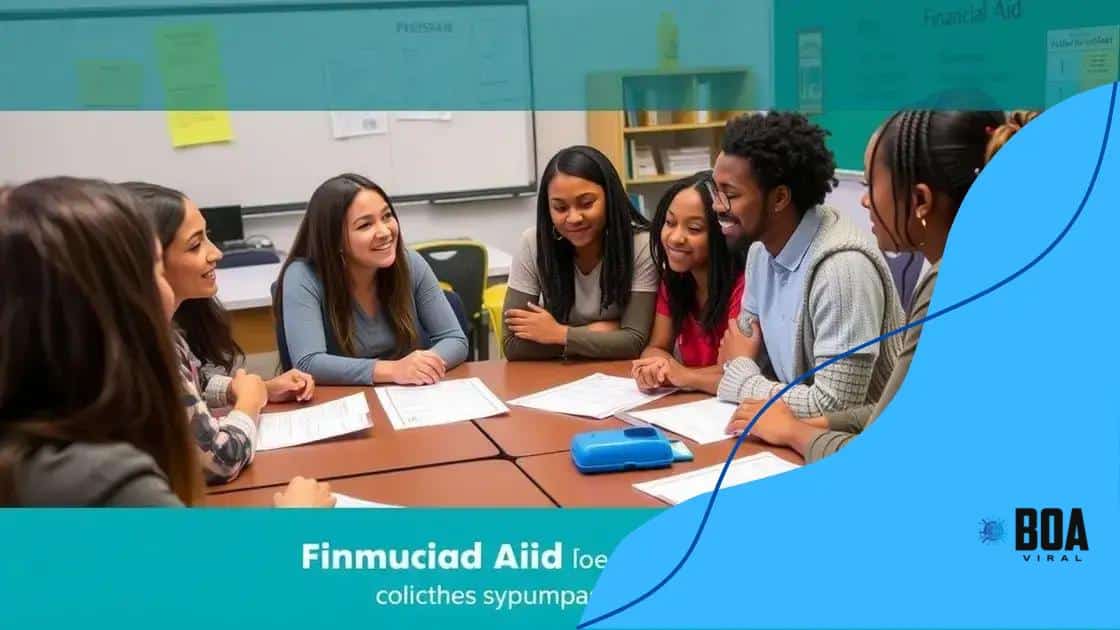National FAFSA reform initiative: What you need to know

The National FAFSA reform initiative simplifies the financial aid process, expands eligibility for loans, increases awareness of alternative funding options, and emphasizes the importance of financial literacy for students seeking higher education funding.
The National FAFSA reform initiative is here to reshape the landscape of financial aid for students across the country. Have you wondered how these changes could make a difference for you or your family? Let’s delve into what this means for education funding.
Understanding the national FAFSA reform initiative
The National FAFSA reform initiative aims to simplify the financial aid process for students. Understanding these changes can greatly affect how families plan for college expenses.
Key Aspects of the Reform
This reform puts forth significant modifications to the existing FAFSA process, making it easier for students to access financial assistance. One major improvement is the reduction in the number of questions on the FAFSA. Fewer questions mean a quicker and less daunting experience for applicants.
- Streamlined application process
- Increased eligibility for aid
- Better guidance for applicants
Moreover, it also addresses the challenges that families face when applying for loans. By simplifying requirements, more students may find they qualify for the support they need. The focus is on reducing barriers and ensuring that financial aid is accessible to all who need it.
Importance of the Changes
It’s important to recognize how these changes will impact students. By making financial aid applications easier to complete, the initiative encourages more families to apply. This can lead to an increase in college enrollment rates.
- Encourages higher education
- Supports lower-income families
- Promotes equity in education
Ultimately, understanding the national FAFSA reform initiative means recognizing its potential to reshape the future of higher education financing. These adjustments not only help students apply for aid but also aim to create a more equitable opportunity for all aspiring college students.
Key changes and updates to FAFSA
The key changes and updates to FAFSA are designed to make the application process more accessible and efficient for students and families. These changes aim to reduce confusion and increase the number of applicants who can receive financial aid.
Streamlined Application Process
One major update is the simplification of the application. The number of questions on the FAFSA has been significantly reduced. This streamlined process is intended to save time and lessen the burden on applicants.
- Fewer questions mean quicker applications.
- Less information required from families.
- More user-friendly interface for online submissions.
Additionally, the new FAFSA aims to clarify eligibility criteria. More families will now meet the requirements for receiving funding. Understanding this can make a big difference in planning for higher education expenses.
Increased Transparency and Support
Another critical update focuses on providing better guidance for applicants. The initiative includes resources that help families understand the financial aid process better. Having clear instructions is essential, especially for first-time applicants.
- Dedicated support resources available online.
- Improved FAQs and troubleshooting guides.
- Access to real-time assistance during the application period.
This emphasis on support ensures that students aren’t left alone during the application process. By investing in transparency, the FAFSA reform initiative seeks to foster confidence in the financial aid system.
How the reform affects financial aid eligibility

The reform of the FAFSA notably impacts financial aid eligibility for many students. These changes are aimed at broadening access to funding for those who need it most.
Expanded Income Thresholds
One significant change is the adjustment of income thresholds. Families with slightly higher incomes may now qualify for financial aid, making college more attainable for a broader range of students. This expansion aims to ensure that support is given to those who genuinely require assistance despite modest earnings.
- Increased income limits for eligibility
- More families can access grants and loans
- A focus on supporting middle-income families
The reform also introduces new considerations for assets. This means that the assets that families hold will be treated differently, reducing the impact on aid eligibility.
Changes in Dependency Status
Another critical aspect of the reform is how dependency status is determined. Students classified as dependents of their parents will see different criteria applied. This change allows for a clearer understanding of who qualifies for various types of aid, based on their unique situations.
- Clarification of dependent versus independent status
- Better reflection of students’ actual circumstances
- Supports students who may need more autonomy in their education
These changes ultimately add flexibility and fairness to financial aid eligibility, making it easier for students to find the support they need. By capturing a wider audience, the FAFSA reform initiative seeks to empower more learners to pursue higher education.
Tips for navigating the new FAFSA process
Navigating the new FAFSA process can seem daunting, but with the right tips, you can make it easier. Knowing what to expect helps to reduce stress and confusion.
Prepare Your Documents
Before starting your application, gather all necessary documents. This preparation will save you time and ensure you have everything you need at your fingertips. Key documents typically include:
- Your tax returns from the previous year.
- W-2 forms and other income records.
- Information about your family’s assets.
Having these documents ready will allow for a smoother application process and reduce the chances of errors.
Understand the Changes
It is essential to stay informed about the key changes in the FAFSA. Familiarize yourself with how the new income thresholds and dependency statuses operate. This could affect your eligibility for different types of aid, so being informed is crucial.
- Review the updated FAQs on the FAFSA website.
- Attend workshops or webinars offered by schools or community organizations.
- Consult with a financial aid advisor if you have specific questions.
Engaging with these resources will help clarify the process and ensure you understand your options.
Fill Out the FAFSA Early
Completing the FAFSA as soon as possible is advisable. Financial aid is often awarded on a first-come, first-served basis, and submitting your application early increases your chances of receiving funds.
Don’t wait until the deadline to start. The earlier you submit, the more likely you are to get the aid you need.
Double-Check Your Information
Accuracy is crucial when completing the FAFSA. Before submitting your application, take the time to review all information. Even small errors can impact your eligibility for aid. Ensure that:
- Your social security number is correct.
- All income and asset figures are accurate.
- There are no typos in your contact information.
Taking these steps will greatly improve your chances of a successful application.
The future of student loans and education funding
The future of student loans and education funding is a topic of great concern and interest for many students and families. With ongoing changes in policies and practices, it’s essential to understand what lies ahead.
New Policies on Student Loans
As the government looks to address student debt, many proposals are being discussed. This includes potential loan forgiveness programs and changes to interest rates. Understanding these policies will help students make informed financial decisions.
- Discussion of loan forgiveness plans for specific professions.
- Potential for lower interest rates to ease the financial burden.
- Increased support for borrowers facing hardships.
These initiatives reflect a shift towards supporting students in managing their educational costs more effectively.
Alternative Funding Options
Beyond traditional loans, alternative funding sources are gaining popularity. Scholarships, grants, and income-sharing agreements offer students different routes to fund their education.
- More scholarships are becoming available through private organizations.
- Grants that do not require repayment are being expanded.
- Income-sharing agreements allow students to pay tuition based on future earnings.
Exploring these options can greatly reduce the financial strain associated with higher education.
Emphasis on Financial Literacy
As students face an evolving financial landscape, the need for financial literacy has never been more critical. Schools and institutions are increasingly offering programs to help students understand their financial obligations and options.
This education can empower students to make better choices regarding loans and repayment plans. Access to clear information will guide them in navigating their financial futures.
Students and families must stay informed about these changes. By understanding the trends and options available, they can better prepare for the costs of higher education, ensuring that funding does not become a barrier to achieving their academic goals.
FAQ – Frequently Asked Questions about Student Loans and Education Funding
What are the latest changes to student loan policies?
The latest changes include discussions on loan forgiveness programs and reduced interest rates aimed at easing student debt.
How can I find alternative funding options for my education?
You can look for scholarships, grants, and income-sharing agreements that provide various routes to fund your education without traditional loans.
Why is financial literacy important for students?
Financial literacy helps students make informed decisions about their loans and repayment plans, ensuring they understand their financial obligations.
When should I apply for FAFSA to maximize my financial aid?
It’s best to submit your FAFSA application as early as possible since financial aid is often awarded on a first-come, first-served basis.






